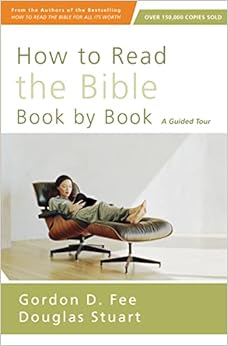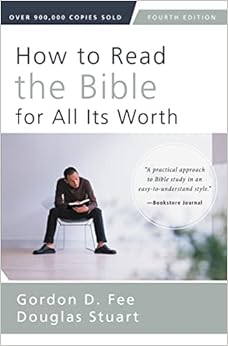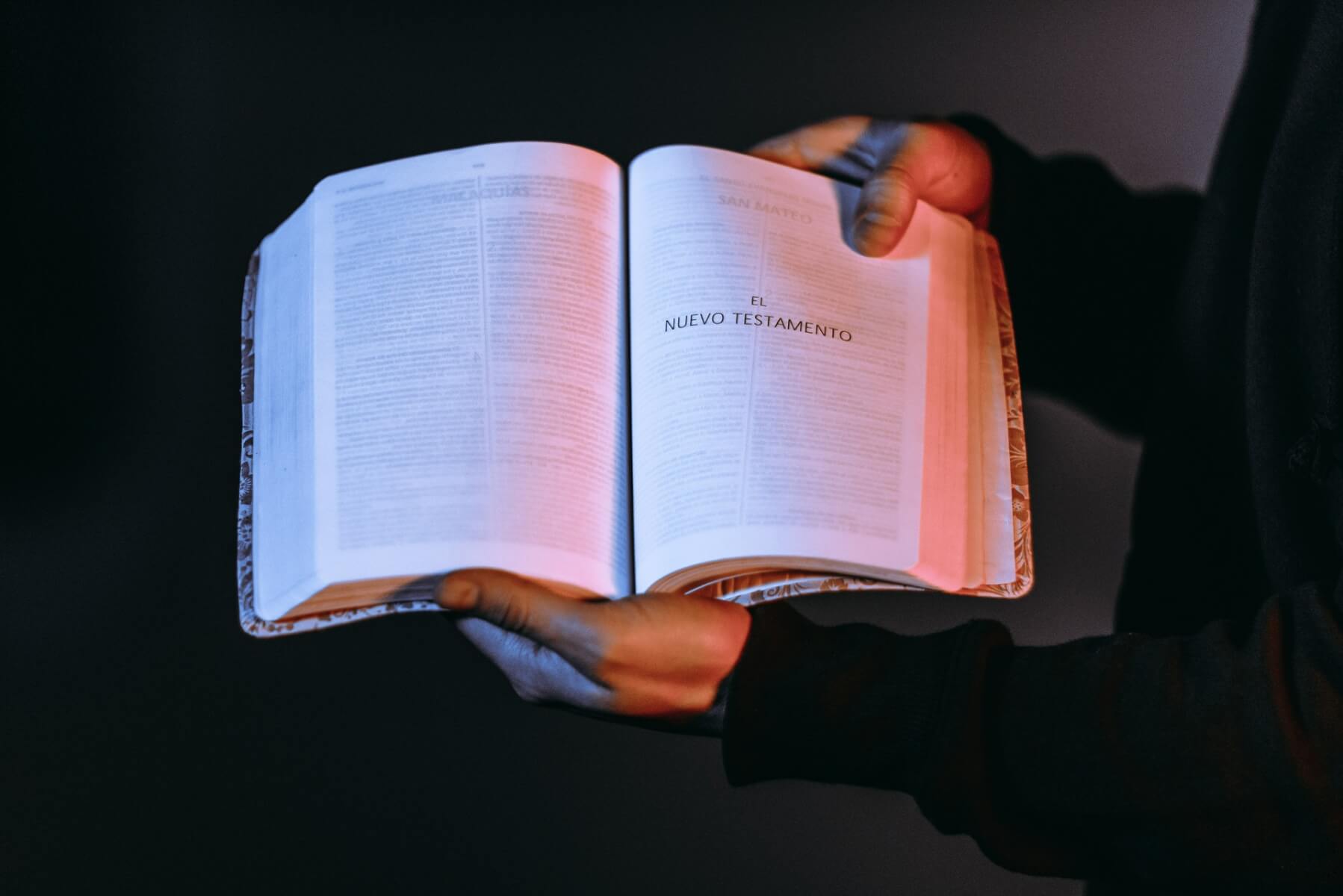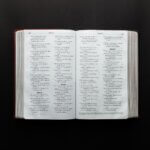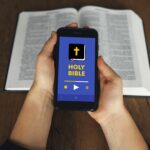17).
Reading it well and faithfully should be something we take seriously.
But how do we read the Bible?
It was written thousands of years ago in different languages within cultures you’re not familiar with, right? What the heck do I do with Leviticus? Which version should I read? Also, why the heck are there 50 versions?
We’re going to (hopefully) answer all of these questions and more in this post. Utilize the sidebar if you want to skip around!
What Is the Bible?
We hear a lot about when to read the Bible, how to read the Bible, and why to read the Bible. But I don’t often hear much about what the Bible is. And I think it’s a really important place to start. So let’s first look at four things that are true of the Bible to give ourselves a sturdy foundation as we dig into how to read it:
The Bible is Human and Divine
This is important to remember because I think many of us approach the scriptures with the idea that they were floated down from a cloud directly from the quill of God. While we believe the Bible to be God’s Word directly from His mouth, I think we can overemphasize its divine nature and forget that it was authored by humans.
God has always worked through humans to accomplish His purposes. We are His choice of instrument in bringing His Kingdom to Earth.
So what does this mean for us? It should help us not to get hung up in the minutiae around the Bible.
For example, many Christians struggle with the fact that there have been different manuscripts of the old and new testaments floating around throughout history. How can we be sure what we’re reading is right?
If we view the Bible as only divine and not human, it can be easy to think this makes it illegitimate. But if we remember the Bible is also human, and that God is sovereign and has always been sovereign over the Bible’s authorship, curation, and publishing – then we can rest knowing that it’s still His living, breathing Word.
The Bible is Full of Different Literature
Some say reading the Bible is like reading a collection of different books organized into one. This is a pretty good illustration, but a better one is this:
Reading the Bible is kind of like going to the library and pulling a few books from every single section in the library and setting them on a table: a few novels, some poem books, ancient wisdom, law books, history books, letters, and a book about the end of time.
It’s crucial we understand this. The Bible is full of different types of literature. And we read different types of literature in different ways.
You read poetry differently than you read a novel differently than you read a personal letter from a friend. The same applies to the Bible.
We must be careful not to take the Bible’s poetry and apocalyptic prophecy too literally. We need to watch what portions of the Old Testament story we take as a prescription or commandment. And we need to be careful not to hone in on one specific portion of a letter apart from its overarching theme.
The Bible is Meditation Literature
Psalm 1 helps us to understand this truth.
“Blessed is the man who does not walk in the counsel of the wicked or stand in the way of sinners or sit in the seat of mockers.
But his delight is in the law of the LORD, and on his law he meditates day and night.” (Psalm 1:1-2)
The Bible is ancient Jewish literature that is designed to interpret itself and encourage a lifetime of re-reading and reflection. Because the Bible was designed as one unified story made up of different pieces, each part was crafted with an eye toward what comes later, precisely to anticipate and foreshadow themes and ideas that are developed later in the story.
The Bible was intended to be meditated on over the course of a lifetime. There are themes, ideas, and truths that should take us years to really understand.
Does this mean it’s impossible to read it effectively if you’ve only just begun? Or that we won’t really get it unless we’re biblical scholars? Not at all. But it is a deep well of wisdom and life – and one can’t fully grasp or master it in a 10 minute quiet time every few days.
The Bible is Contextually Rooted
Last, but certainly not least, the Bible is rooted in its context. Related to the idea above of the Bible being both human and divine, God chose human beings in specific time periods within specific cultures to write the Bible.
This means that each book is full of cultural and historical references that we can’t understand outside of their original context.
Does this mean the Bible isn’t truly “living and active?” Not at all. It just means at times, we have to do a little work in order to properly understand a book, chapter, or verse.
Everytime we pick up the Bible, we bring our own preconceived notions based on the time and place we live. There’s nothing wrong with this – it’s nearly impossible not to – but we must try our best to put these aside and pay attention to the time period and culture of the writer.
Two quick examples, one obvious and one not-so-obvious:
- Take up your cross: when we read this, it’s hard for us to grasp the gravity of the command without understanding the Roman rule and their popular execution tactic. If we weren’t familiar with crucifixion, this would mean little-to-nothing to us. But when the disciples heard it in real time, they would have been baffled.
- Wages in Matthew 20:1-16: If you didn’t know that a denarius was equivalent to a full day’s wage, it would be really hard to know the significance of Jesus’ parable.
If you’ve been a Christian for some time, you’re probably somewhat familiar with a lot of the Bible’s historical context thanks to sitting in hundreds of sermons. Nonetheless, we must continue to commit to honoring the Bible’s historical context as we come to understand it better.
And one final note: it’s okay to use outside resources to help you understand the Bible. The Holy Spirit is far and away our best resource, but there’s nothing wrong with grabbing a commentary to help you grasp historical and literary context.
The Old Testament & New Testament
The Bible is made up of two parts: the Old Testament and the New Testament. The Old Testament is centered around the covenants God made with Abraham, Noah, and Moses. It also contains poetry and prophecies of the coming Messiah.
The New Testament is made up of the Gospels recounting the life of Jesus, apostolic letters, and Revelation. It’s centered around the New Covenant and the Kingdom ushered in by Jesus.
Understanding how the two work together is really important if we’re to read the Bible faithfully.
What the Bible is Not
I’m stealing these directly from the guys at The Bible Project. Sorry – and also thank you – to Tim and Jon.
- A Theology Dictionary. The Bible is not intended primarily to be a dictionary or encyclopedia that we reference only when we have a question. Though it has many answers to life’s questions, if we approach it in this way, we miss out on the bigger story it’s telling. This approach can lead us to craft answers to questions the Bible isn’t necessarily asking.
- A Moral Handbook. It’s not a handbook or a rulebook. A rulebook tells people what to do, while the wisdom of the bible “is designed to form certain kinds of people who need fewer rules because the convictions expressed by those rules have become a part of their character.”
- A Devotional Grab Bag. When we look at the Bible like a treasure chest to pull out little bits of wisdom and insight each morning that make us feel good about ourselves, we miss out on the overarching story, and we are able to easily sidestep more difficult – but important – scriptures.
And one more thing to add here – the Bible has not been changed or altered over time. It is authoritative and reliable.
Why Read the Bible?
Now that we’re familiar with what the Bible is and what it is not, let’s address the why. Most faithful Christians know the Bible is vital to our lives, but sometimes we struggle to put our finger on exactly why. Though there are probably hundreds of reasons, let’s look at just a few:
The Bible is the Word of God
“All scripture is God-breathed…” (2 Timothy 3:16a)
The God of the universe has spoken! He has revealed Himself to us. We should be interested in what He has to say.
God has chosen to reveal Himself to humanity in two primary ways: creation and His Word. Creation should generally point us to Him, while His Word tells us more specifically who He is, who we are, and what His will is.
Though it was authored, edited, and curated by humans, we believe He divinely inspired every inch of the Bible.
So if we want to get to know Him, the Bible should be our primary source for doing so. And not only to learn facts about Him, but to truly come to know Him. Reading the Bible is worship. In it we see His beauty more clearly.
The Bible Trains Us in Righteousness
“All Scripture is God-breathed and is useful for teaching, rebuking, correcting and training in righteousness, so that the servant of God may be thoroughly equipped for every good work.” (2 Timothy 3:16-17)
The Bible is profitable and useful to the Christian. It teaches us, rebukes us, corrects, us and trains us in righteousness, that we might be fully equipped to do whatever He’s called us to do.
The Bible transforms us. As we see the beauty of who He is, we are changed into His image (2 Corinthians 3:16-17). As we dig into its truths, we are having our minds renewed that we may know what the will of God is (Romans 12:1-2).
In it is everything we need to live a life worthy of the calling of the Lord.
The Bible Shows Us Who We Are
“For the word of God is alive and active. Sharper than any double-edged sword, it penetrates even to dividing soul and spirit, joints and marrow; it judges the thoughts and attitudes of the heart.” (Hebrews 4:12)
The Bible primarily shows us who God is, but it also has plenty to say about who we are. Hebrews tells us it penetrates us deeply, judging the thoughts and attitudes of the heart.
The Bible is like a mirror for us, showing us not only who we are as mankind, but who we are personally. It reveals deep desires, thoughts, and longings inside of us.
How to Read the Bible
There are many different approaches to reading the Bible. In our opinion, you should use a variety of different approaches as you read the scriptures to fully grasp the story of the Bible. But before we look at some different approaches, let’s talk about some pointers and tips that will help us as we approach the Bible.
Tips for Effective Bible Reading
- Humble Yourself: If you sit down with the scriptures feeling as if you have everything figured out and the Word has little to offer you, you’ll miss out on its power.
- Pray through It: We need help to read the Bible in a way reveals God and changes us – and our best help is God Himself. Ask for help as you read it.
- See the Word as Authority: We are most moldable and shapable by the Word when we recognize it as authoritative, and willingly submit ourselves to God through it.
- Do it in Community: Most of the Bible’s books were delivered not to individuals, but to communities. We were intended to read it alongside others.
- View the Bible as a Unified Story: Fight the urge to treat the Bible like a reference book. It is one unified story pointing to the Messiah. Read it like this.
- Remember the Genre: The Bible is made up of many different types of literature – each one should be approached a little differently. Always take note of the genre.
Different Approaches to Reading the Bible
There are lots of different ways to read through the Bible. We want to highlight just a few and talk about the pros and cons of each.
The Daily Devotional Approach
Though we’ve said in this article the Bible isn’t meant to be a “devotional grab bag,” that doesn’t mean we can’t read it as devotional. There’s absolutely nothing wrong with sitting down with a couple verses each day, using a devotional book as a guide, or following along with the daily scripture from the Bible app.
This is a great approach when we only have a few minutes to dig into the scriptures. It can help us tune our hearts to God, hear from Him, and give us a thought to reflect on and pray throughout the day.
That said, this isn’t the only way we should read the Bible. When we only read the Bible like this, we can miss out on the bigger picture, only get a surface-level understanding of Biblical themes, and sometimes intentionally bypass more difficult sections of scripture.
The Reading Plan Approach
Reading plans are a great way to help you structure your time in the Word and keep you disciplined. There are probably thousands of reading plans out there these days, ranging from the Bible in a year to different plans that tackle specific topics.
Here are a few great Bible reading plans:
- The Bible in a Year: There are lots of different organizations and churches with their own Bible in a year plan. Some have you read straight through, while others might have you read a little New Testament, Old Testament and a Psalm each day. You can also find chronological plans. Just Google them! It might seem like it takes a long time to read the Bible, but you can knock it out more quickly than you think.
- The Robert Murray M’Cheyne Bible Plan: This is a classic, but still popular plan that takes you through different themes. You can find the plan here.
- 5×5 New Testament Plan by Navigators: This is a great plan for someone just starting out reading the Bible. It takes just 5 minutes a day. Check it out here.
- The Bible in 90 Days: If you want to quickly read through the Bible and get a good overview without reading each verse, this is a great plan.
The Book-by-Book Approach
Reading the Bible book-by-book is – in our opinion – the best way to read the Bible. This doesn’t mean you can’t also follow a plan or a devotional, but you should make time occasionally for more focused studying. And moving book-by-book is one of the best ways to do that.
Written By: Gordon Fee
This is one of the single best books on how to read the Bible. The authors take you through each book and teach you how to implement their approach.
This process can look many different ways, but here’s what we’d recommend:
- Pick a book you want to start with. Mark and John are great places to start if you’ve never read through the Bible before.
- Get familiar with the genre. Iis it a letter, narrative, poetry, wisdom literature, etc?
- Learn the background. Who wrote the book, who was it written to, what was their intent, what time period was it written in, etc?
- Determine the structure. You know in school when some teachers asked you to read the section in your textbook before coming to class? When you have a good idea of the structure of what you’re about to read, it can help your comprehension. So take a skim through the book and look at the headings in your Bible. If you have a study Bible, it might give you some insight in the intro. You can also check out the videos from the Bible Project guys – a really great resource.
- Start reading. You can move as quickly or slowly as you’d like. Some people like to read through a book a few times and then go back through slowly. You can read a chapter per day or a few verses per day. Let the book and its flow dictate how you read through it.
- Take notes and journal. This is one of the best ways to get more familiar with the Bible. Take notes as you read, jot down questions, make connections, etc…
- Talk with friends about what you’re reading. Don’t try to read the Bible alone. Talk to friends, ask questions, and bounce ideas off of each other.
- Consider a commentary to help. The Bible isn’t the easiest book to grasp. We often need help understanding the historical and literary context to really understand a book. Commentaries are a great help here.
The Thematic Study Approach
One final approach some take to reading the Bible is to study or trace a theme from start to finish. For example, you may want to learn more about the Holy Spirit, so you read about every instance or mention of the Holy Spirit throughout the scriptures, to get a Biblical understanding of Him.
The Robert Murray M’Cheyne Bible Plan mentioned above is a great plan for doing this. You can also (yet again) check out the Bible Project app where they trace different themes throughout the scriptures.
Frameworks for Reading the Bible
If you’re reading the Bible on your own, whether following a yearly plan or reading the Bible book-by-book, it can be really helpful to have a framework for your reading time. Often when we read a portion of scripture, we can be left thinking, “Okay, now what? I’m not really sure how to interpret this or what it means for me.”
A framework can help us get the most out of our time in the scriptures. Here are three popular frameworks, in order of simplicity:
- SOAP: SOAP stands for: Scripture, Observation, Application, Prayer. It’s a super simple way of reading your Bible and applying what you learn.
- 7 Arrows: This framework consists of seven questions to ask yourself as you read through a passage. They are:
- What does the passage say?
- What did this passage mean to its original audience?
- What does this passage tell us about God?
- What does this passage tell us about man?
- What does this passage demand of me?
- How does this passage change the way I relate to people?
- How does this passage prompt me to pray to God?
- Inductive Bible Study: This is a seven step process for studying the Bible made popular by Navigators:
- Get familiar with the background of the book / passage
- Personally paraphrase the passage
- Write down questions and then answer them for better understanding
- Make note of similar or related passages that come to mind
- Make note of any insights you gain, and consult a commentary for additional insight
- Personal application
- Give the chapter or passage a title and summarize it
All of these frameworks are great approaches. You don’t have to follow any certain one, just make sure your brain is turned on as you read the scriptures. What gets processed and meditated on in the mind eventually works its way to our heart and soul.
And we can’t reiterate this enough: root your scripture reading in prayer. Invite the Holy Spirit to illuminate truths for you.
Written By: Gordon Fee
This is probably the best book on how to approach reading the Bible for beginners. I learned a TON the first time I read it, highly recommend.
What Order Should You Read the Bible In?
If you do set out to read the Bible book-by-book or you want to read it straight through, you might wonder what order you should read the Bible in, or “where should I start reading the Bible?” This is a great question we get asked a lot. Here are a few of our recommendations:
- Start with a simple reading plan that takes you through the Bible pretty quickly without reading every single word of every book. This Bible in 90 Days plan is a good one.
- Start by reading one of the Gospels – lots of people recommend John or Mark. This will be your best introduction to the life and teachings of Jesus.
I would aim to make it through the whole Bible at some point – but there’s no rush.
And final thought: you don’t have to be a Bible scholar to faithfully follow Jesus. There’s a lot to learn from the Word – and we believe it is central to the life of the believer – but don’t feel like a sub-par Christian because you’re just getting started reading the Bible and you aren’t a theological wizard.
How to Choose a Bible Version
There are lots of different versions of the Bible. We won’t go into too much detail here, but we do want to briefly speak to why that is.
Why Are There Different Versions of the English Bible?
The Old Testament was originally written mostly in Hebrew, with a few Aramaic elements. The New Testament was written mostly in Greek.
In the early days of Christianity, most of the world was Greek speaking, so the Old Testament was translated into Greek in what’s known as the Septuagint. As Christianity spread, the Bible was translated into more languages like Coptic, Ethiopian, Gothic, and Latin.
Fast forward a bit to the 1300s and the Bible was translated into English for the first time in 1382. A few other English translations arose, and all were culminated ultimately into the King James Version in 1611.
Translating things from old languages into new languages is a very difficult task, and there are many disagreements among scholars, leading to all of the different Bible translations. Essentially, if enough Biblical scholars have a problem with a few translation choices in a Bible, they gather together and produce their own. That’s why there are so many different translations.
Not to mention that there’s not necessarily always a right or wrong when it comes to translating a Greek word to English – sometimes it comes down to preference. It’s not always black and white.
What’s the Difference in Bible Translations?
There are a lot, but in short, the biggest differentiator between translations is how “freely” the words are translated.
In some translations like the KJV and NKVJ, a more literal word-by-word approach is taken. This might mean that individual words are accurately translated, but the idea or overarching meaning of a passage is missed.
Other translations like The Message are more freely translated where entire paragraphs or chapters are paraphrased, so that the individual words are probably far off from the original words used, but the overarching theme is likely more accurate.
And then somewhere in the middle is a more dynamic approach, where both the individual words used and the overarching points are considered.
Textual analysis is a science that I myself am no expert on.
What Bible Version Should I Use?
There’s no right answer or “best” version, but some of the most well-respected and widely used versions are:
- The NIV Bible (dynamic in translation)
- The ESV Bible (fairly dynamic, with a slight literal lean)
- The NLT Bible (fairly dynamic, with a slight free lean)
- The Message and The Passion Translation (both very free, and we wouldn’t recommend only reading these, but can be helpful for new Bible readers)
It may also be worth considering a study Bible to help you get a better understanding of the text.

